Wavenumber-4 Structure in COSMIC-2 Observations: Vertical Plane Perspective
Abstract
:1. Introduction
2. Data and Analysis
3. Results
3.1. Characteristics of Wavenumber Structures
3.2. Characteristics of Wavenumber Structures in the Vertical Plane
3.3. Propagation of WN4 Structure over EIA Crest/Trough
4. Discussion
Note on Observational Limitation of RO Technique
5. Conclusions
- (a)
- The longitudinal extent of the titled phase front in the WN4 component is of the order of the longitudinal extent of the local-time wavenumber, i.e., 900.
- (b)
- The WN4 structure in the F region over the EIA crest region is found to be out of phase (in phase) with respect to the EIA trough region during daytime (nighttime).
- (c)
- Above ~400 km, the WN4 structures in the EIA crest and trough regions are seen to be in phase with each other at all local times.
Author Contributions
Funding
Data Availability Statement
Acknowledgments
Conflicts of Interest
References
- Sagawa, E.; Immel, T.J.; Frey, H.U.; Mende, S.B. Longitudinal structure of the equatorial anomaly in the nighttime ionosphere observed by IMAGE/FUV. J. Geophys. Res. 2005, 110, A11302. [Google Scholar] [CrossRef]
- Immel, T.J.; Sagawa, E.; England, S.L.; Henderson, S.B.; Hagan, M.E.; Mende, S.B.; Frey, H.U.; Swenson, C.M.; Paxton, L.J. Control of equatorial ionospheric morphology by atmospheric tides. Geophys. Res. Lett. 2006, 33, L15108. [Google Scholar] [CrossRef]
- England, S.L.; Maus, S.; Immel, T.J.; Mende, S.B. Longitudinal variation of the E-region electric fields caused by atmospheric tides. Geophys. Res. Lett. 2006, 33, L21105. [Google Scholar] [CrossRef]
- Lühr, H.; Rother, M.; Häusler, K.; Alken, P.; Maus, S. The influence of nonmigrating tides on the longitudinal variation of the equatorial electrojet. J. Geophys. Res. 2008, 113, A08313. [Google Scholar] [CrossRef]
- Fejer, B.G.; Jensen, J.W.; Su, S.-Y. Quiet time equatorial F region vertical plasma drift model derived from ROCSAT-1 observations. J. Geophys. Res. 2008, 113, A05304. [Google Scholar] [CrossRef]
- Lin, C.H.; Wang, W.; Hagan, M.E.; Hsiao, C.C.; Immel, T.J.; Hsu, M.L.; Liu, J.Y.; Paxton, L.J.; Fang, T.W.; Liu, C.H. Plausible effect of atmospheric tides on the equatorial ionosphere observed by the FORMOSAT-3/COSMIC: Three-dimensional electron density structures. Geophys. Res. Lett. 2007, 34, L11112. [Google Scholar] [CrossRef]
- Scherliess, L.; Thompson, D.C.; Schunk, R.W. Longitudinal variability of low-latitude total electron content: Tidal influences. J. Geophys. Res. 2008, 113, A01311. [Google Scholar] [CrossRef]
- Wan, W.; Liu, L.; Pi, X.; Zhang, M.-L.; Ning, B.; Xiong, J.; Ding, F. Wavenumber-4 patterns of the total electron content over the low latitude ionosphere. Geophys. Res. Lett. 2008, 35, L12104. [Google Scholar] [CrossRef]
- Pedatella, N.M.; Hagan, M.E.; Maute, A. The comparative importance of DE3, SE2, and SPW4 on the generation of wavenumber-4 longitude structures in the low-latitude ionosphere during September equinox. Geophys. Res. Lett. 2012, 39, L19108. [Google Scholar] [CrossRef]
- Chang, L.C.; Lin, C.-H.; Yue, J.; Liu, J.-Y.; Lin, J.-T. Stationary planetary wave and nonmigrating tidal signatures in ionospheric wave 3 and wave 4 variations in 2007–2011 FORMOSAT-3/COSMIC observations. J. Geophys. Res. Space Phys. 2013, 118, 6651–6665. [Google Scholar] [CrossRef]
- Onohara, A.N.; Batista, I.S.; Batista, P.P. Wavenumber-4 structures observed in the low-latitude ionosphere during low and high solar activity periods using FORMOSAT/COSMIC observations. Ann. Geophys. 2018, 36, 459–471. [Google Scholar] [CrossRef]
- Maute, A.; Richmond, A.D.; Roble, R.G. Sources of low-latitude ionospheric E × B drifts and their variability. J. Geophys. Res. 2012, 117, A06312. [Google Scholar] [CrossRef]
- Hagan, M.E.; Forbes, J.M. Migrating and nonmigrating diurnal tides in the middle and upper atmosphere excited by tropospheric latent heat release. J. Geophys. Res. 2002, 107, 4754. [Google Scholar] [CrossRef]
- Hagan, M.E.; Forbes, J.M. Migrating and nonmigrating semidiurnal tides in the upper atmosphere excited by tropospheric latent heat release. J. Geophys. Res. 2003, 108, 1062. [Google Scholar] [CrossRef]
- Forbes, J.M.; Russell, J.; Miyahara, S.; Zhang, X.; Palo, S.; Mlynczak, M.; Mertens, C.J.; Hagan, M.E. Troposphere-thermosphere tidal coupling as measured by the SABER instrument on TIMED during July–September 2002. J. Geophys. Res. 2006, 111, A10S06. [Google Scholar] [CrossRef]
- Oberheide, J.; Wu, Q.; Killeen, T.L.; Hagan, M.E.; Roble, R.G. Diurnal nonmigrating tides from TIMED Doppler Interferometer wind data: Monthly climatologies and seasonal variations. J. Geophys. Res. 2006, 111, A10S03. [Google Scholar] [CrossRef]
- Oberheide, J.; Wu, Q.; Killeen, T.L.; Hagan, M.E.; Roble, R.G. A climatology of nonmigrating semidiurnal tides from TIMED Doppler Interferometer (TIDI) wind data. J. Atmos. Sol.—Terr. Phys. 2007, 69, 2203–2218. [Google Scholar] [CrossRef]
- Forbes, J.M.; Zhang, X.; Palo, S.; Russell, J.; Mertens, C.J.; Mlynczak, M. Tidal variability in the ionospheric dynamo region. J. Geophys. Res. 2008, 113, A02310. [Google Scholar] [CrossRef]
- Häusler, K.; Lühr, H. Nonmigrating tidal signals in the upper thermospheric zonal wind at equatorial latitudes as observed by CHAMP. Ann. Geophys. 2009, 27, 2643–2652. [Google Scholar] [CrossRef]
- Liu, H.; Yamamoto, M.; Lühr, H. Wave-4 pattern of the equatorial mass density anomaly: A thermospheric signature of tropical deep convection. Geophys. Res. Lett. 2009, 36, L18104. [Google Scholar] [CrossRef]
- Jin, H.; Miyoshi, Y.; Fujiwara, H.; Shinagawa, H. Electrodynamics of the formation of ionospheric wave number 4 longitudinal structure. J. Geophys. Res. 2008, 113, A09307. [Google Scholar] [CrossRef]
- Lei, J.; Thayer, J.P.; Wang, W.; Yue, J.; Dou, X. Nonmigrating tidal modulation of the equatorial thermosphere and ionosphere anomaly. J. Geophys. Res. Space Phys. 2014, 119, 3036–3043. [Google Scholar] [CrossRef]
- Pancheva, D.; Miyoshi, Y.; Mukhtarov, P.; Jin, H.; Shinagawa, H.; Fujiwara, H. Global response of the ionosphere to atmospheric tides forced from below: Comparison between COSMIC measurements and simulations by atmosphere-ionosphere coupled model GAIA. J. Geophys. Res. 2012, 117, A07319. [Google Scholar] [CrossRef]
- Pancheva, D.; Mukhtarov, P. Global Response of the Ionosphere to Atmospheric Tides Forced from Below: Recent Progress Based on Satellite Measurements. Space Sci. Rev. 2012, 168, 175–209. [Google Scholar] [CrossRef]
- Niu, J. Relationship between wavenumber 4 pattern of sporadic E layer intensity and eastward propagating diurnal tide with zonal wavenumber 3 in low latitude region. J. Geophys. Res. Space Phys. 2021, 126, e2020JA028985. [Google Scholar] [CrossRef]
- Lühr, H.; Rother, M.; Häusler, K.; Fejer, B.; Alken, P. Direct comparison of non-migrating tidal signatures in the electrojet, vertical plasma drift and equatorial ionization anomaly. J. Atmos. Sol.—Terr. Phys. 2012, 75–76, 31–43. [Google Scholar] [CrossRef]
- Schreiner, W.S.; Sokolovskiy, S.V.; Rocken, C.; Hunt, D.C. Analysis and validation of GPS/MET radio occultation data in the ionosphere. Radio Sci. 1999, 34, 949–966. [Google Scholar] [CrossRef]
- Cai, X.; Qian, L.; Wang, W.; McInerney, J.M.; Liu, H.-L.; Eastes, R.W. Hemispherically asymmetric evolution of nighttime ionospheric equatorial ionization anomaly in the American longitude sector. J. Geophys. Res. Space Phys. 2022, 127, e2022JA030706. [Google Scholar] [CrossRef]
- He, M.; Liu, L.; Wan, W.; Wei, Y. Strong evidence for couplings between the ionospheric wave-4 structure and atmospheric tides. Geophys. Res. Lett. 2011, 38, L14101. [Google Scholar] [CrossRef]
- Syndergaard, S. A new algorithm for retrieving GPS radio occultation total electron content. Geophys. Res. Lett. 2002, 29, 55-1–55-4. [Google Scholar] [CrossRef]
- Nicolls, M.J.; Rodrigues, F.S.; Bust, G.S.; Chau, J.L. Estimating E region density profiles from radio occultation measurements assisted by IDA4D. J. Geophys. Res. 2009, 114, A10316. [Google Scholar] [CrossRef]
- Wu, D.L. New global electron density observations from GPS-RO in the D- and E-Region ionosphere. J. Atmos. Sol.—Terr. Phys. 2018, 171, 36–59. [Google Scholar] [CrossRef]
- Yue, X.; Schreiner, W.S.; Lei, J.; Sokolovskiy, S.V.; Rocken, C.; Hunt, D.C.; Kuo, Y.-H. Error analysis of Abel retrieved electron density profiles from radio occultation measurements. Ann. Geophys. 2010, 28, 217–222. [Google Scholar] [CrossRef]
- Wu, K.; Su, C.; Chu, Y. Improvement of GPS radio occultation retrieval error of E region electron density: COSMIC measurement and IRI model simulation. J. Geophys. Res. Space Phys. 2015, 120, 2299–2315. [Google Scholar] [CrossRef]
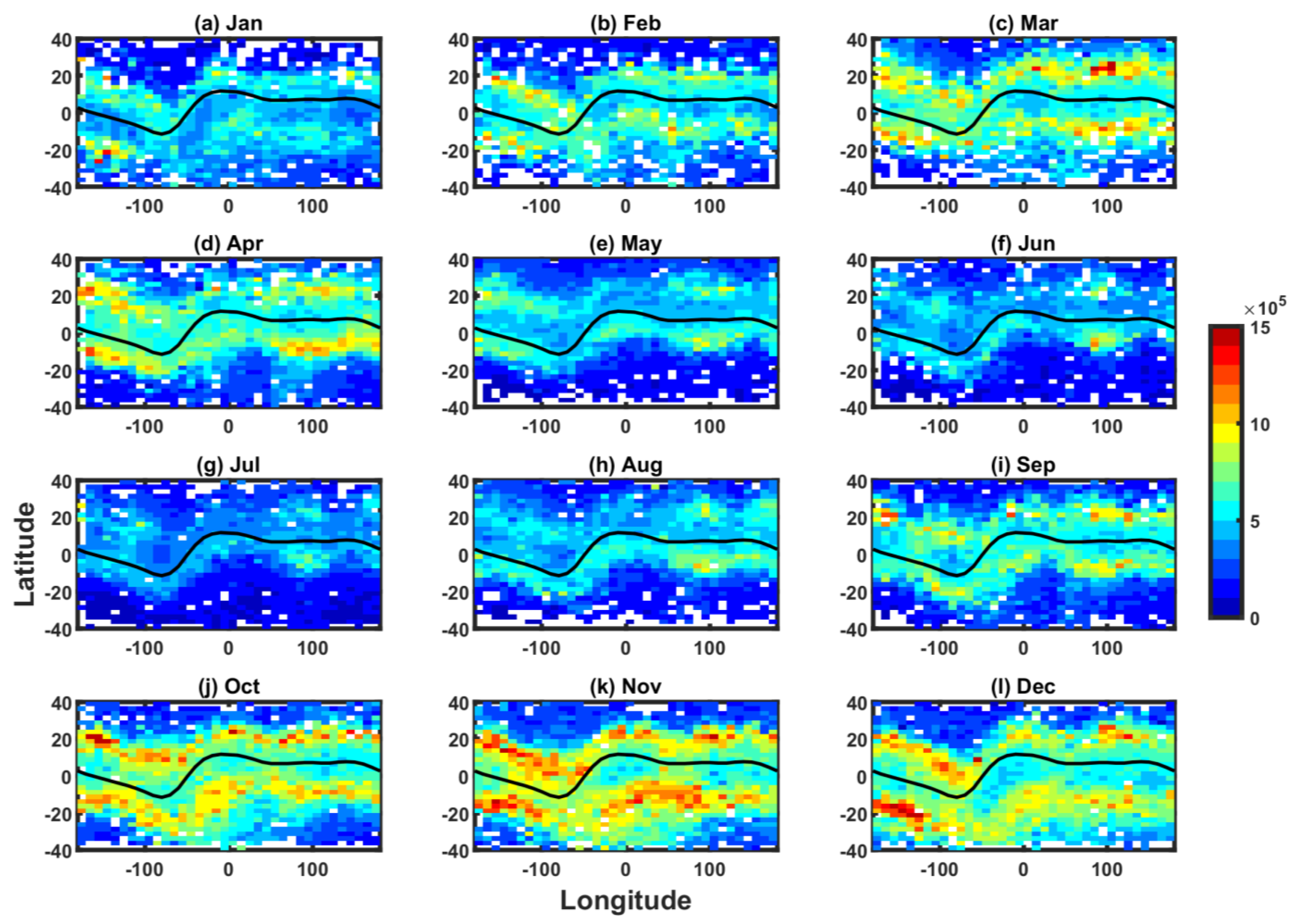
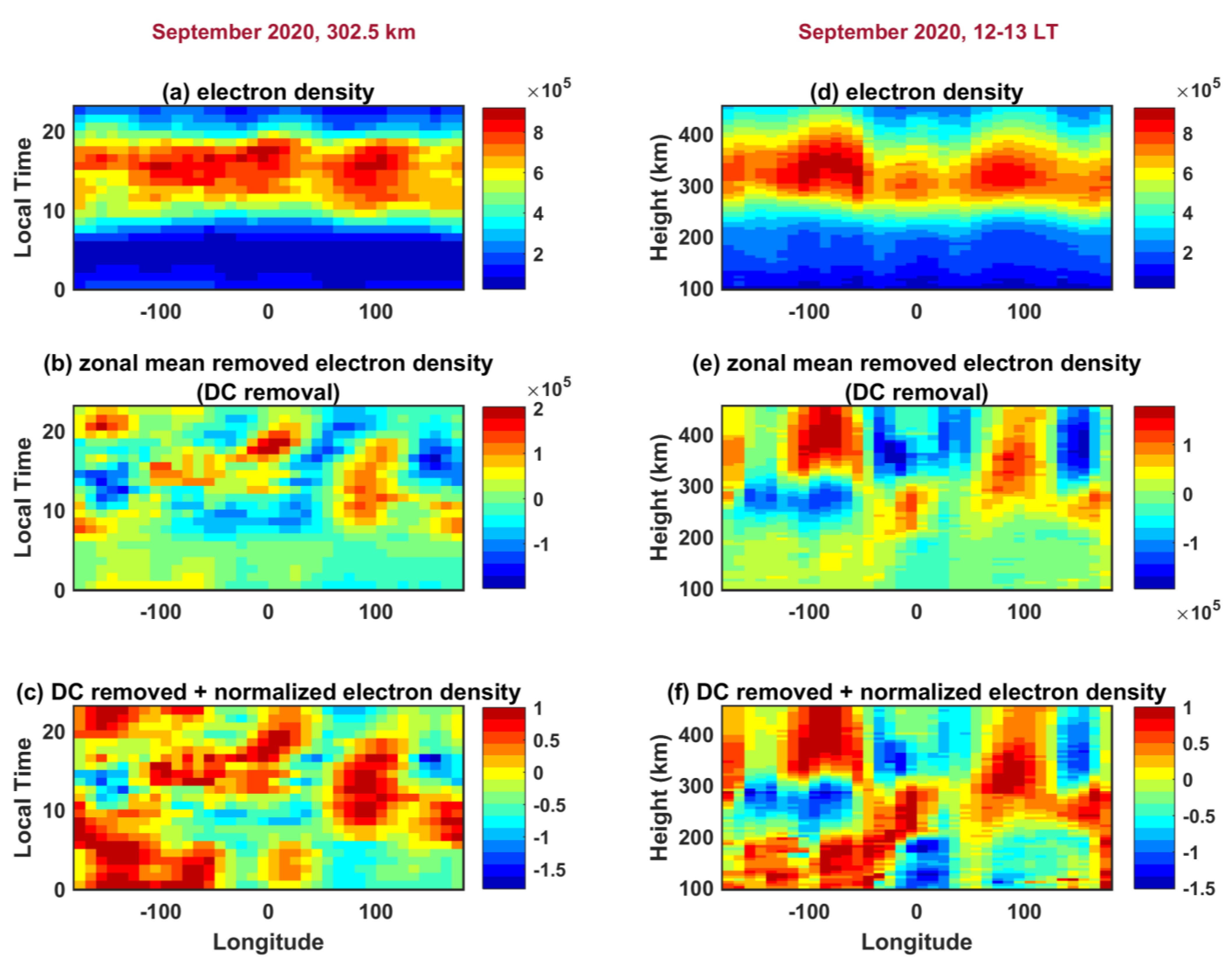


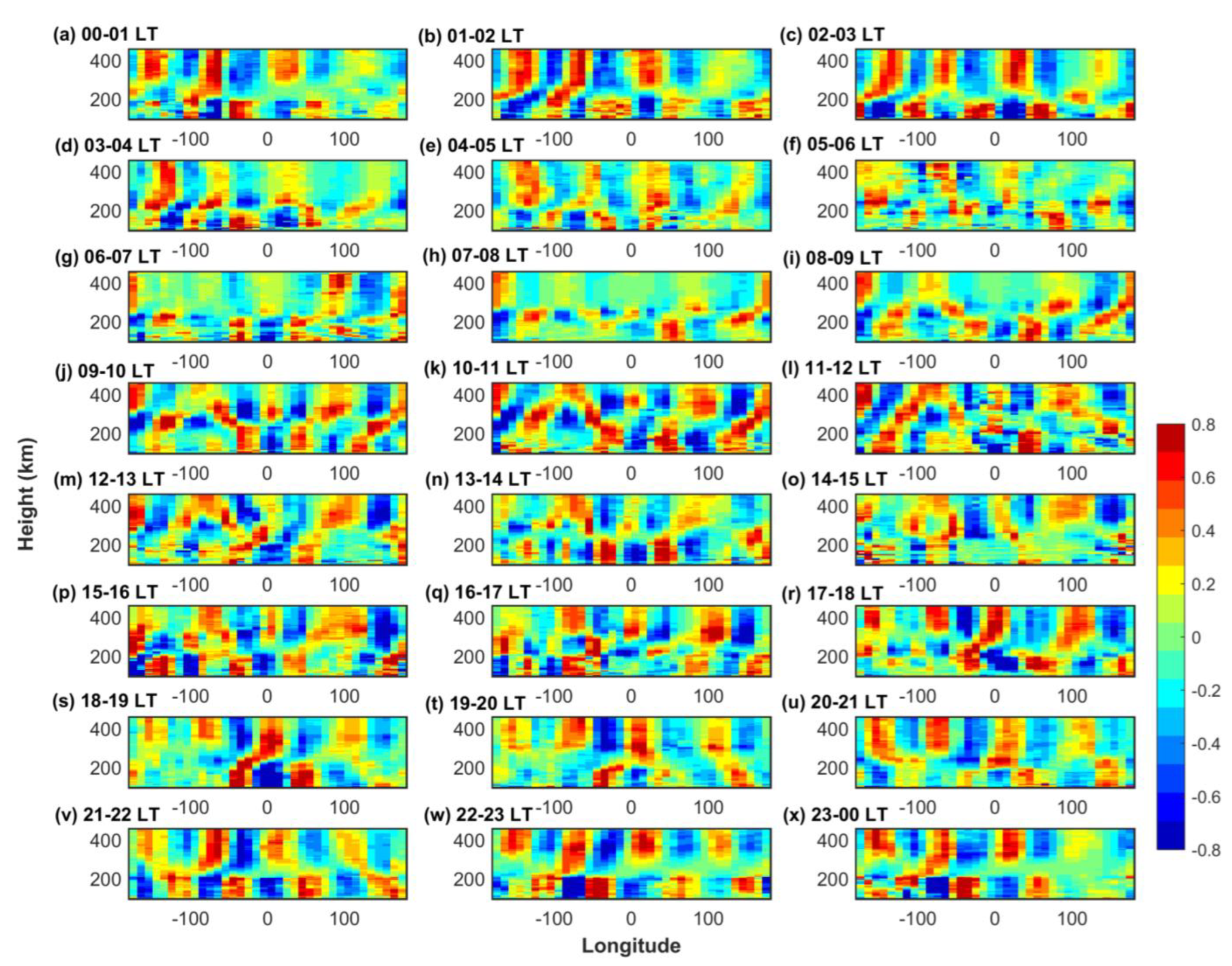

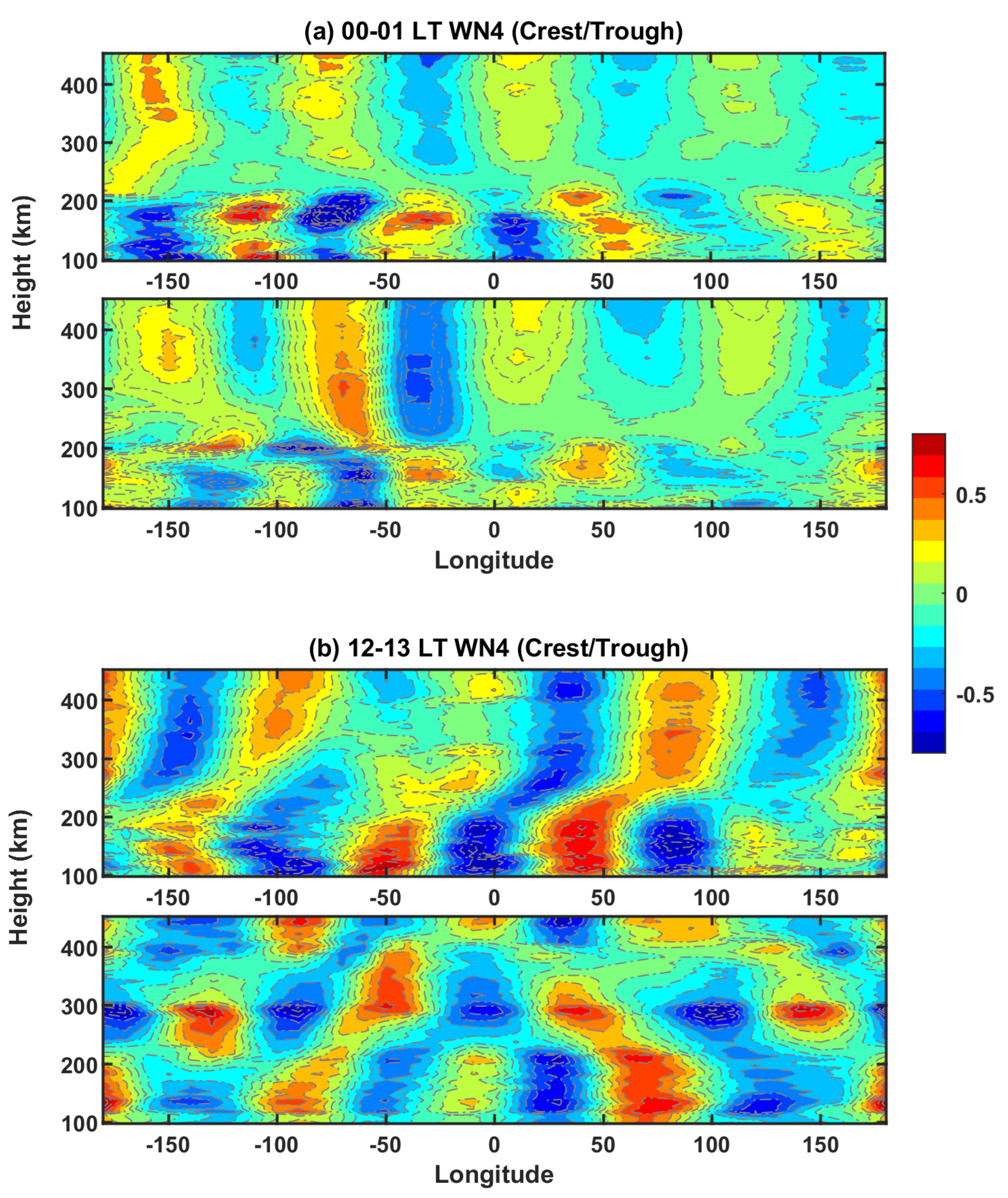
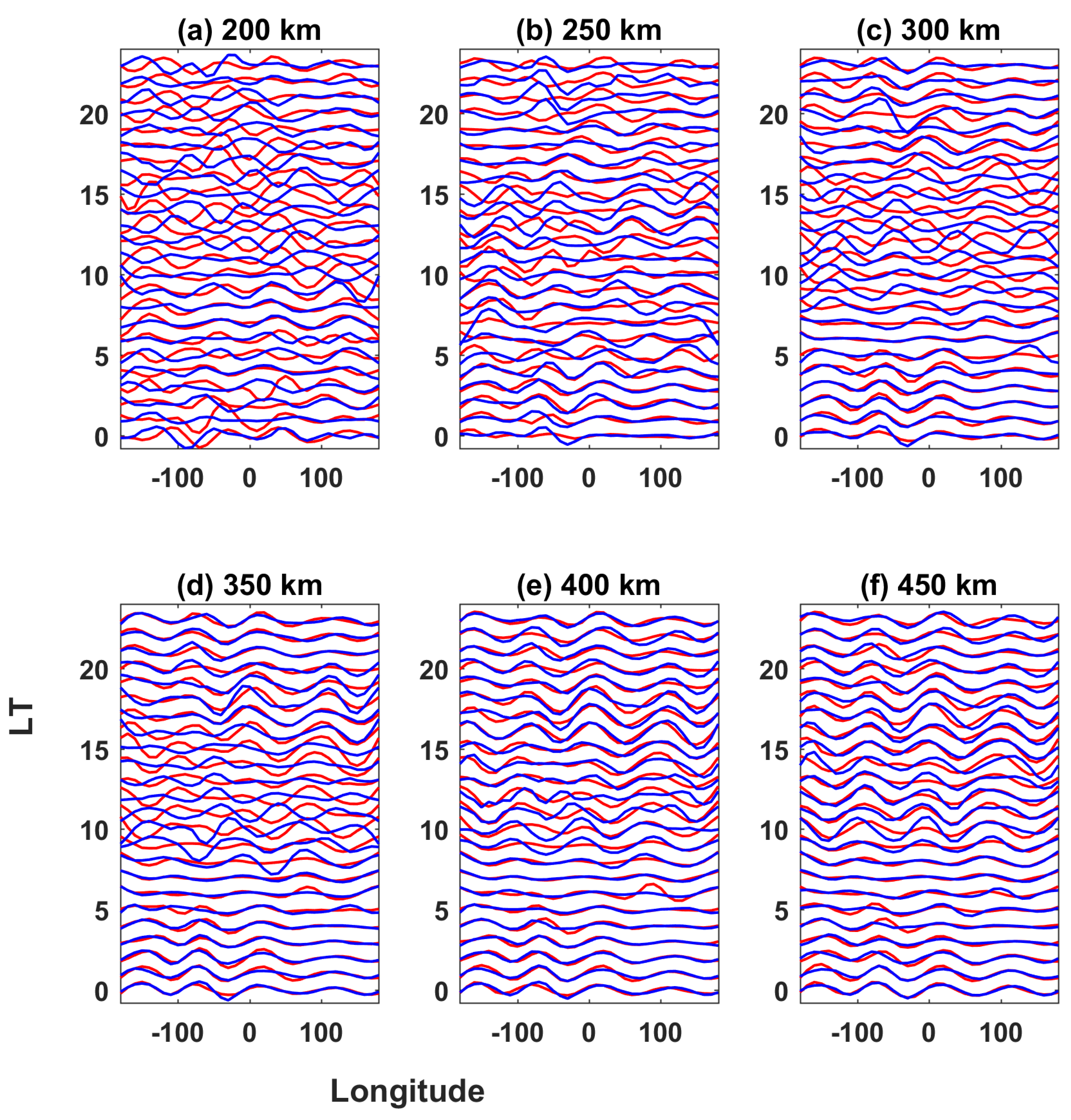
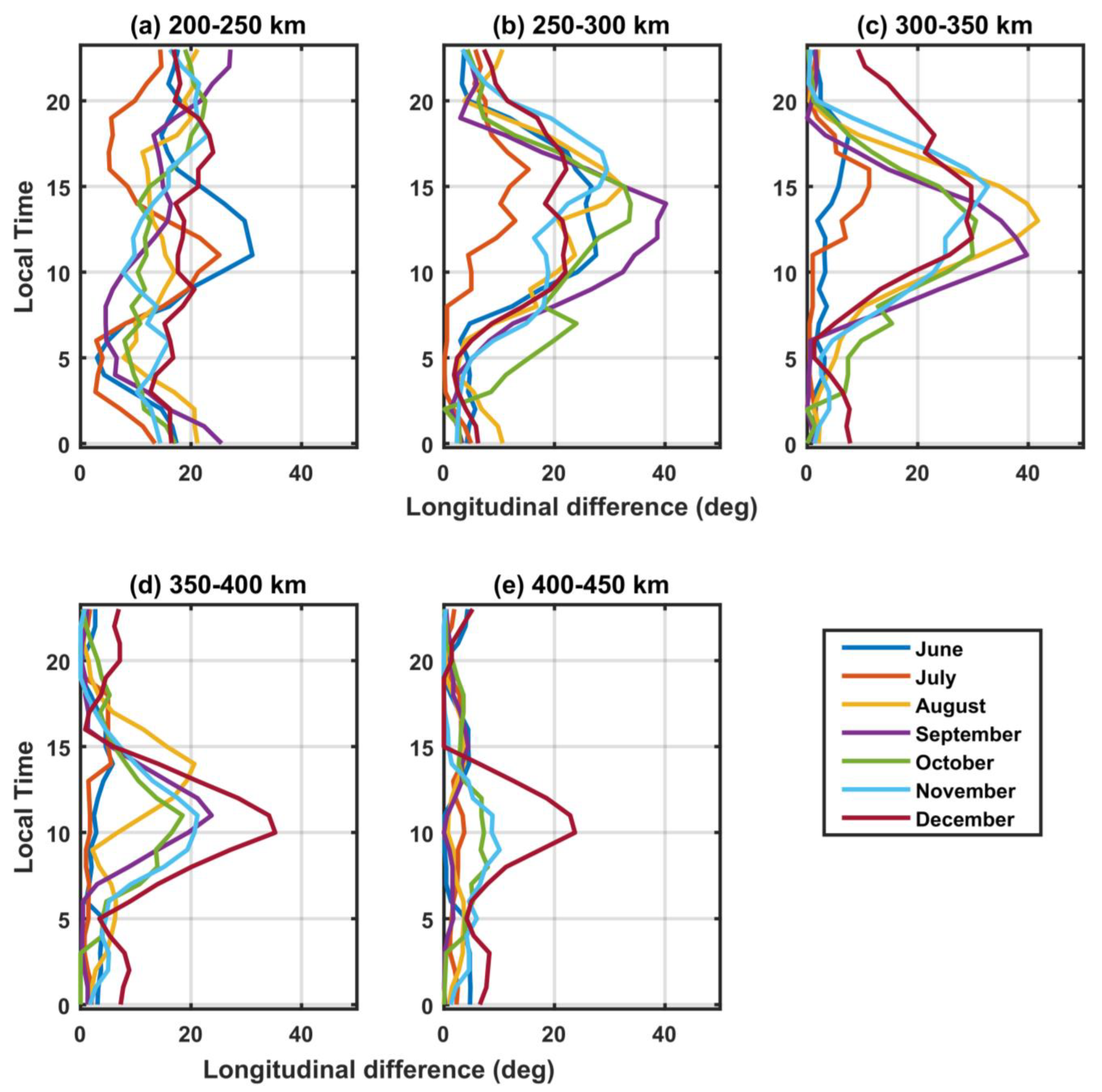
Disclaimer/Publisher’s Note: The statements, opinions and data contained in all publications are solely those of the individual author(s) and contributor(s) and not of MDPI and/or the editor(s). MDPI and/or the editor(s) disclaim responsibility for any injury to people or property resulting from any ideas, methods, instructions or products referred to in the content. |
© 2023 by the authors. Licensee MDPI, Basel, Switzerland. This article is an open access article distributed under the terms and conditions of the Creative Commons Attribution (CC BY) license (https://creativecommons.org/licenses/by/4.0/).
Share and Cite
Joshi, L.M.; Tsai, L.-C.; Su, S.-Y. Wavenumber-4 Structure in COSMIC-2 Observations: Vertical Plane Perspective. Remote Sens. 2023, 15, 2105. https://doi.org/10.3390/rs15082105
Joshi LM, Tsai L-C, Su S-Y. Wavenumber-4 Structure in COSMIC-2 Observations: Vertical Plane Perspective. Remote Sensing. 2023; 15(8):2105. https://doi.org/10.3390/rs15082105
Chicago/Turabian StyleJoshi, Lalit Mohan, Lung-Chih Tsai, and Shin-Yi Su. 2023. "Wavenumber-4 Structure in COSMIC-2 Observations: Vertical Plane Perspective" Remote Sensing 15, no. 8: 2105. https://doi.org/10.3390/rs15082105
APA StyleJoshi, L. M., Tsai, L.-C., & Su, S.-Y. (2023). Wavenumber-4 Structure in COSMIC-2 Observations: Vertical Plane Perspective. Remote Sensing, 15(8), 2105. https://doi.org/10.3390/rs15082105








